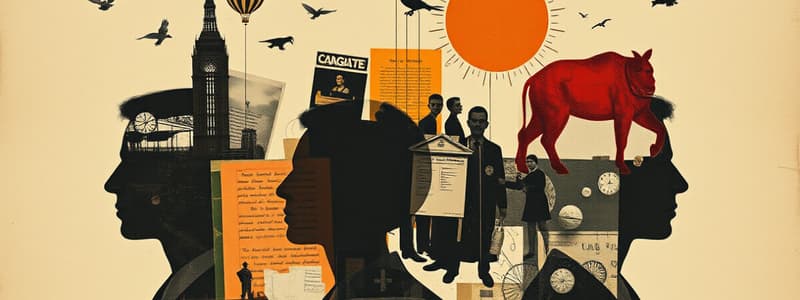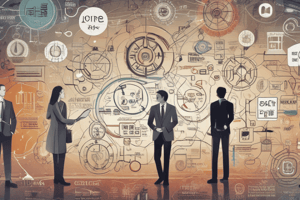Podcast
Questions and Answers
Which dimension of organizational culture is characterized by experimenting and risk-taking?
Which dimension of organizational culture is characterized by experimenting and risk-taking?
- Innovation (correct)
- Stability
- Attention to detail
- Outcome orientation
What term describes a culture that exists in smaller groups within an organization, sharing core values but with additional characteristics?
What term describes a culture that exists in smaller groups within an organization, sharing core values but with additional characteristics?
- Corporate culture
- Dominant culture
- Subculture (correct)
- Counterculture
Which dimension reflects an organization's focus on fairness and tolerance?
Which dimension reflects an organization's focus on fairness and tolerance?
- Stability
- Team orientation
- Respect for people (correct)
- Aggressiveness
Countercultures within an organization typically do what in relation to the dominant culture?
Countercultures within an organization typically do what in relation to the dominant culture?
Which organizational culture dimension is characterized by a high focus on achieving results and high expectations?
Which organizational culture dimension is characterized by a high focus on achieving results and high expectations?
Which dimension of organizational culture emphasizes collaboration and a people-oriented approach?
Which dimension of organizational culture emphasizes collaboration and a people-oriented approach?
What role does language play in organizational culture?
What role does language play in organizational culture?
Which of the following is an example of a ritual in an organizational setting?
Which of the following is an example of a ritual in an organizational setting?
How do artifacts manifest within an organization?
How do artifacts manifest within an organization?
What does the phrase 'put the moose on the table' signify in Galvanize's culture?
What does the phrase 'put the moose on the table' signify in Galvanize's culture?
Which component of organizational culture involves conscious beliefs about what is good or bad?
Which component of organizational culture involves conscious beliefs about what is good or bad?
What is primarily represented by stories and legends in an organizational culture?
What is primarily represented by stories and legends in an organizational culture?
What is the primary definition of organizational culture according to Aristotle?
What is the primary definition of organizational culture according to Aristotle?
Which of the following is NOT a factor that influences organizational culture?
Which of the following is NOT a factor that influences organizational culture?
What makes changing organizational culture particularly challenging?
What makes changing organizational culture particularly challenging?
What is a method to validate the culture of an organization?
What is a method to validate the culture of an organization?
Which statement about culture within an organization is true?
Which statement about culture within an organization is true?
Which of the following best describes the concept of enacted values vs. espoused values in organizational culture?
Which of the following best describes the concept of enacted values vs. espoused values in organizational culture?
What is one primary purpose of an organization's culture?
What is one primary purpose of an organization's culture?
How can a moderately stronger culture impact an organization?
How can a moderately stronger culture impact an organization?
What term describes the bond that holds employees together within an organization?
What term describes the bond that holds employees together within an organization?
What is a characteristic of a strong organizational culture?
What is a characteristic of a strong organizational culture?
Which of the following is NOT a function of strong organizational cultures?
Which of the following is NOT a function of strong organizational cultures?
What is necessary for culture strength advantages to be effective?
What is necessary for culture strength advantages to be effective?
What role do rewards play in organizational culture?
What role do rewards play in organizational culture?
How can leaders effectively communicate and model the desired organizational culture?
How can leaders effectively communicate and model the desired organizational culture?
What is the primary risk associated with high employee turnover in an organization?
What is the primary risk associated with high employee turnover in an organization?
What does the socialization process for new employees involve?
What does the socialization process for new employees involve?
Which term describes the process when a merged firm allows both corporate cultures to coexist?
Which term describes the process when a merged firm allows both corporate cultures to coexist?
What is a primary characteristic of transformational leaders in the context of organizational culture?
What is a primary characteristic of transformational leaders in the context of organizational culture?
Flashcards are hidden until you start studying
Study Notes
Identifying Culture
- Organizational culture comprises values and assumptions shaping behavior patterns within an organization.
- Influential components include structure, processes, rewards, and leadership styles.
Culture Truths & Challenges
- Organizational culture is deeply ingrained, akin to a company's DNA, making it challenging to change.
- There is often inconsistency in interpreting culture, leading to confusion between enacted and espoused values.
- Cultures can fragment into subcultures and "cliques," complicating clear understanding.
Validating Culture
- Methods to assess culture include observing employee behaviors and artifacts, analyzing decision-making processes, and debriefing actions taken.
Elements of Organizational Culture
- Culture expressed through:
- Artifacts: Physical manifestations of culture (e.g., logos, office layout).
- Language: Communication styles, titles, and terminologies used within the organization.
- Rituals and Ceremonies: Established routines and celebrations that reinforce cultural norms.
- Stories and Legends: Narratives that shape identity and illustrate values.
- Conscious Beliefs: Established values and moral judgments.
- Implicit Mental Models: Unwritten rules governing expected behaviors.
Artifacts of Culture
- Language reflects employee interactions and emotional expressions.
- Rituals incorporate engagement practices (e.g., Walmart greeters), self-presentation norms (dress codes), and decision-making processes (empowerment structures).
Organizational Culture Common Types
- Innovation: Values experimentation and risk-taking.
- Stability: Focuses on predictability and security.
- Respect for People: Emphasizes fairness and tolerance.
- Outcome Orientation: Prioritizes action and results.
- Attention to Detail: Values precision and analytics.
- Team Orientation: Encourages collaboration and support.
- Aggressiveness: Highlights a competitive mindset with less emphasis on social responsibility.
Organizational Subcultures
- Dominant Culture: Broadly shared values, influencing overall organization.
- Subcultures: Smaller groups with shared core values but distinct characteristics (e.g., marketing team).
- Countercultures: Oppose aspects of the dominant culture (e.g., "meetingless" teams).
Organizational Culture & Performance
- Culture acts as a control system, social glue, and a sense-making mechanism.
- A moderately strong culture contributes to improved performance.
Organizational Culture Strength
- Culture strength relies on how deeply employees share dominant values and assumptions.
- A strong culture is institutionalized through artifacts and may be long-lasting.
Changing/Strengthening Organizational Culture
- Leaders play a crucial role in communicating and modeling desired culture.
- Align artifacts (process, office design, language) with the intended culture.
- Utilize culturally consistent rewards to reinforce cultural traits.
- Prioritize workforce stability and clear communication to maintain strong culture.
- Focus on recruiting and socializing new employees to align them with the existing culture.
Merging Organizational Cultures
- Assimilation: Acquired staff adopts the culture of the acquiring firm.
- Deculturation: The acquiring firm enforces its policies and practices.
- Integration: A new culture is formed by preserving the best aspects of both prior cultures.
- Separation: Merged organizations retain their individual cultures.
Organizational Socialization
- A process where individuals learn organizational values, behaviors, and necessary social knowledge.
- Newcomers make sense of organizational dynamics and form relationships while adjusting to new roles and norms.
Studying That Suits You
Use AI to generate personalized quizzes and flashcards to suit your learning preferences.




